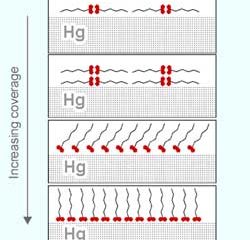
The name is Fung. Daniel Y.C. Fung
He may not possess the lethal aggression or magnetism of the fictitious secret agent James Bond, but like Agent 007, Daniel Y.C. Fung is always on a mission of deadly proportions. While Bond’s assignments usually involve international intrigue and saving the world from evil villains, Fung’s life’s work is devoted to saving the world ’s food supply from deadly pathogens and bacteria. And where Ian Fleming’s cool, hard hero ha

For more than a decade, researchers have been trying to create accurate computer models of Escherichia coli (E. coli), a bacterium that makes headlines for its varied roles in food poisoning, drug manufacture and biological research.
By combining laboratory data with recently completed genetic databases, researchers can craft digital colonies of organisms that mimic, and even predict, some behaviors of living cells to an accuracy of about 75 percent.
Now, NSF-supported researchers

Scientists open door to possible new treatments for urinary tract infections
Clingy bacteria often spell trouble. Scientists at Washington University School of Medicine in St. Louis have discovered how bacteria manufacture hair-like fibers used to cling to the lining of the kidney and bladder where they cause urinary tract infections (UTIs). The results are published in the Nov. 15 issue of the journal Cell.
“Our findings should lead to new drugs to treat UTIs by blocking t

A gene may be responsible for halting the spread of cancer through the body, according to scientists at the University of Virginia Health System. The gene, called RhoGDI2, could also be used as a warning to help catch the spread of cancer in patients earlier. A multidisciplinary team of scientists, led by Dr. Dan Theodorescu, professor of urology and molecular physiology at U.Va., used advanced DNA technology to discover that low levels of RhoGDI2 were found more often in invasive cancer than in loca

A team of scientists from the U.S. Department of Energy’s Brookhaven National Laboratory, Harvard University, and Bar-Ilan University in Israel have grown ultrathin films made of organic molecules on the surface of liquid mercury. The results, reported in the November 15, 2002, issue of Science, reveal a series of new molecular structures that could lead to novel applications in nanotechnology, which involves manipulating materials at the atomic scale.
Growing molecular films on liquid

Scientists at The Scripps Research Institute report
Professor Richard A. Lerner, M.D., Associate Professor Paul Wentworth, Jr., Ph.D., and a team of investigators at The Scripps Research Institute (TSRI) is reporting that antibodies can destroy bacteria, playing a hitherto unknown role in immune protection. Furthermore, the team found that when antibodies do this, they appear to produce the reactive gas ozone.
“[Ozone] has never been considered a part of biology before,” say

– new calculation confirms standard model of particle physics. Contribution of hadronic vacuum polarization determined with unprecedented accuracy. The magnetic moment of the muon is an important precision parameter for…
Technique may prevent formation of unwanted waves that siphon off needed energy. Heating plasma to the ultra-high temperatures needed for fusion reactions requires more than turning the dial on a…

An international team of astronomers, led by researchers from the Astronomical Observatory of the University of Warsaw, have identified a new class of cosmic X-ray sources. The findings have been…

How deubiquitinases USP53 and USP54 cleave long polyubiquitin chains and how the former is linked to liver disease in children. Deubiquitinases (DUBs) are enzymes used by cells to trim protein…

Conceptual blueprint to analyze experimental catalyst data. Machine learning (ML) models have recently become popular in the field of heterogeneous catalyst design. The inherent complexity of the interactions between catalyst…

Antibody that Neutralizes Inhibitory Factors Involved in Nerve Regeneration Leads to Enhanced Motor Function after Acute Spinal Cord Injury. Researchers at 13 clinics in Germany, Switzerland, the Czech Republic and…

How simulations help manufacturing of modern displays. Modern materials must be recyclable and sustainable. Consumer electronics is no exception, with organic light-emitting diodes (OLEDs) taking over modern televisions and portable…

“Neurons that fire together, wire together” describes the neural plasticity seen in human brains, but neurons grown in a dish don’t seem to follow these rules. Neurons that are cultured…

The quest for sustainable energy solutions has been a major focus of scientific research for decades. Solar energy, a clean and renewable source, has emerged as a promising alternative to…

With a processing speed a billion times faster than nature, chip-based laser neuron could help advance AI tasks such as pattern recognition and sequence prediction. Researchers have developed a laser-based…

New technology could remotely identify various types of plastics, offering a valuable tool for future monitoring and analysis of oceanic plastic pollution. Researchers have developed a new hyperspectral Raman imaging…

Artificial Intelligence (AI) has established a strong presence across industries, large and small. The “VoBaKI” research project has empowered small and medium-sized enterprises (SMEs) with an innovative tool to independently…